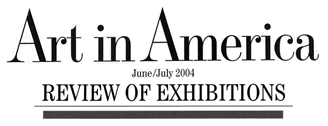 |
||||
| Mary Hambleton at Littlejohn Contemporary | ||||
| Just as each of Mary Hambleton's painting aims to draw the viewer into close examination of its intensely detailed surfaces, so this show as a whole seek to draw one into the artist's thronging, mostly abstract visual universe of optically charged stripes, closely patterned dots and multilayered mark-making. After one had looked at the dozen paintings and works on paper in the front gallery- a substantial show in itself- there came a second gallery that was densely hung with some 30 smaller paintings. The exhibition's sense of plentitude derived not just from the large number of paintings on view and their event-filled surfaces, but also from the fact that Hambleton often uses boxlike supports that allow her to work the sides as well as the fronts of her pieces. Sometimes even the addition of four sides doesn't satisfy this voracious artist, and she places small blocks of painted and collaged wood atop her paintings. A good example is Sidelines (2000-03), a narrow, 16-inch-high, 2 1/2-inch-deep work that features a scumbled surface of striated grays and blacks on its front plane. Demarcating the left edge of this plane is a vertical band of thick, multicolored dried paint, the sort of thing one might see on a studio table. If a viewer standing directly in front of Sidelines moves slightly to the left, another element of the painting comes into view: dozens of horizontal, closely set blue strokes against an orange ground on the left side of the work. The right and top sides are painted a simple bluish gray (I didn't check the bottom , but I suspect that it, too, has been painted). |
On the top, Hambleton stacked some variously colored wood blocks, one of which featured a foliagelike accretion of green paint. As well as satisfying her apparently unquenchable passion for covering flat surfaces with color, Hambleton's choice to place small polychrome sculptures on her paintings may also be a good-natured art-historical joke. Since the heyday of Minimalism, working with extra-thick stretchers or boxy supports has been a standard mode for many abstract painters who call on all sorts of theoretical notions to explain their preferences. "Yes," Hambleton seems to be saying, " a thick painting can be a Judd-like 'specific object,' but it can also serve as a handy shelf. " The playfully colored blocks can also evoke children's toys and games. A veritable encyclopedia of abstract motifs and painterly techniques, this show, which was titled "Nothing By Mouth," represented five years of work. In a recent in-depth interview in the Brooklyn Rail, the artist explained the title as being at once a medical reference that relates to her ongoing battle with cancer and an artistic credo that favors retinal experience, and, indeed, every work in this enjoyably crowded show celebrated the responsiveness of the human eye. -Raphael Rubinstein |
 |
||
| Download a PDF of the article. | ||||